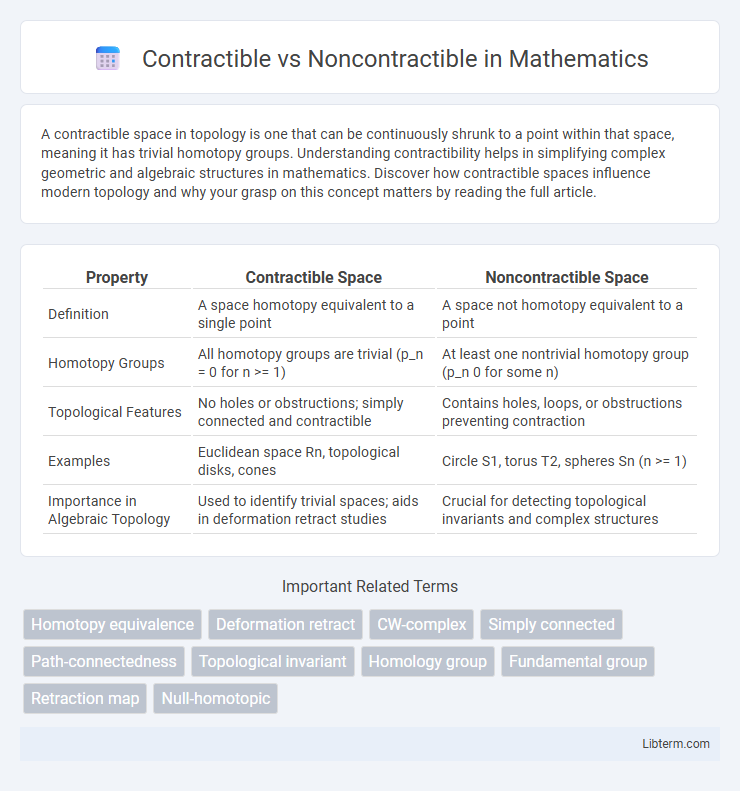A contractible space in topology is one that can be continuously shrunk to a point within that space, meaning it has trivial homotopy groups. Understanding contractibility helps in simplifying complex geometric and algebraic structures in mathematics. Discover how contractible spaces influence modern topology and why your grasp on this concept matters by reading the full article.
Table of Comparison
| Property | Contractible Space | Noncontractible Space |
|---|---|---|
| Definition | A space homotopy equivalent to a single point | A space not homotopy equivalent to a point |
| Homotopy Groups | All homotopy groups are trivial (p_n = 0 for n >= 1) | At least one nontrivial homotopy group (p_n 0 for some n) |
| Topological Features | No holes or obstructions; simply connected and contractible | Contains holes, loops, or obstructions preventing contraction |
| Examples | Euclidean space Rn, topological disks, cones | Circle S1, torus T2, spheres Sn (n >= 1) |
| Importance in Algebraic Topology | Used to identify trivial spaces; aids in deformation retract studies | Crucial for detecting topological invariants and complex structures |
Introduction to Contractibility
Contractibility refers to a topological space's ability to be continuously shrunk to a single point within that space, indicating it has trivial homotopy groups. A contractible space is topologically simple and has no "holes," contrasting with noncontractible spaces that contain essential loops or holes preventing such a deformation. Understanding contractibility is fundamental in algebraic topology for classifying spaces and determining their homotopy equivalence.
Defining Contractible Spaces
Contractible spaces are topological spaces that can be continuously shrunk to a single point within the space, meaning they are homotopy equivalent to a point. This property implies that contractible spaces have trivial fundamental groups and all higher homotopy groups vanish. In contrast, noncontractible spaces possess topological features like holes or loops that prevent such a continuous deformation, highlighting key distinctions in algebraic topology.
Understanding Noncontractible Spaces
Noncontractible spaces are topological spaces that cannot be continuously shrunk to a point, meaning there is no homotopy equivalence to a single point. These spaces often contain essential features such as holes, loops, or other complex structures preventing deformation retraction, exemplified by the fundamental groups that are nontrivial. Understanding noncontractible spaces is crucial in algebraic topology, as it aids in distinguishing between different types of spaces and analyzing their intrinsic geometric and topological properties.
Key Differences Between Contractible and Noncontractible
Contractible spaces can be continuously shrunk to a point within the space, indicating they are topologically simple and have trivial homotopy groups. Noncontractible spaces contain essential holes or structures preventing such continuous deformation, resulting in nontrivial topological features like nonzero homotopy groups. The key difference lies in their homotopy equivalence: contractible spaces are homotopy equivalent to a single point, while noncontractible spaces are not, reflecting their complex topological invariants.
Topological Properties and Their Implications
Contractible spaces are topological spaces that can be continuously shrunk to a point, implying they have trivial fundamental groups and homotopy groups, which simplifies their algebraic topology classification. Noncontractible spaces possess nontrivial homotopy groups, meaning they contain essential loops or holes that prevent deformation to a single point, directly impacting properties like connectedness and compactness. These topological distinctions influence applications in fields such as algebraic topology, geometric group theory, and topological data analysis by determining invariants crucial for mapping space structures and their continuity properties.
Examples of Contractible Spaces
Examples of contractible spaces include Euclidean spaces like \(\mathbb{R}^n\), where any point can be continuously shrunk to a single point within the space. Convex subsets of \(\mathbb{R}^n\), such as open balls or cubes, are also contractible due to their simple geometric structure that allows deformation retraction. In contrast, topological spaces like circles or tori are noncontractible because they contain essential loops that cannot be continuously contracted to a point.
Examples of Noncontractible Spaces
Noncontractible spaces include important examples like the circle \(S^1\), the torus \(T^2\), and the Klein bottle, all of which possess nontrivial fundamental groups preventing continuous deformation to a point. These spaces exhibit topological features such as loops or holes that cannot be contracted, distinguishing them from simply connected or contractible spaces. The real projective plane \(\mathbb{RP}^2\) is another classic example of a noncontractible space with rich geometric and algebraic properties.
Applications in Mathematics and Science
Contractible spaces, such as convex subsets of Euclidean spaces, play a crucial role in algebraic topology by simplifying homotopy analysis, making them fundamental in fixed-point theorems and deformation retracts. Noncontractible spaces, including spheres and tori, are essential for studying complex topological invariants like homology and fundamental groups, which underpin manifold theory and the classification of surfaces. In physics, contractibility aids in fields like gauge theory, while noncontractible loops correspond to topological defects and quantum phenomena in condensed matter systems.
Challenges in Identifying Contractibility
Identifying contractibility poses significant challenges due to complex topological properties that distinguish contractible spaces from noncontractible ones. Key difficulties arise in analyzing the homotopy equivalence and deformation retractability, which require advanced mathematical tools such as homology and homotopy groups. Determining contractibility often involves examining higher-dimensional spaces where intuitive geometric visualization fails, complicating computational algorithms and theoretical proofs.
Summary and Future Directions
Contractible spaces are topological spaces that can be continuously shrunk to a point, indicating trivial homotopy groups, while noncontractible spaces retain essential topological features reflected in nontrivial homotopy. Research continues to explore the implications of contractibility in areas such as algebraic topology, data analysis, and sensor networks, with emerging methods leveraging persistent homology to differentiate complex structures. Future directions include advancing computational tools for identifying contractible components in high-dimensional datasets and applying these concepts to optimize network connectivity and shape recognition.
Contractible Infographic

 libterm.com
libterm.com